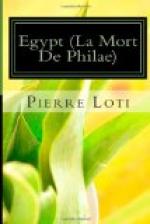Outlined upon the excessive blue of the sky, the summits, illumined to the point of dazzling, rise up in the light—like red cinders of a glowing fire, splendours of living coal, against the pure indigo that turns almost to darkness. We seem to be walking in some valley of the Apocalypse with flaming walls. Silence and death, beneath a transcendent clearness, in the constant radiance of a kind of mournful apotheosis—it was such surroundings as these that the Egyptians chose for their necropoles.
The pathway plunges deeper and deeper in the stifling defiles, and at the end of this “Valley of the Kings,” under the sun now nearly meridian, which grows each minute more mournful and terrible, we expected to come upon a dread silence. But what is this?
At a turning, beyond there, at the bottom of a sinister-looking recess, what does this crowd of people, what does this uproar mean? Is it a meeting, a fair? Under awnings to protect them from the sun stand some fifty donkeys, saddled in the English fashion. In a corner an electrical workshop, built of new bricks, shoots forth the black smoke, and all about, between the high blood-coloured walls, coming and going, making a great stir and gabbling to their hearts’ content, are a number of Cook’s tourists of both sexes, and some even who verily seem to have no sex at all. They are come for the royal audience; some on asses, some in jaunting cars, and some, the stout ladies who are grown short of wind, in chairs carried by the Bedouins. From the four points of Europe they have assembled in this desert ravine to see an old dried-up corpse at the bottom of a hole.




